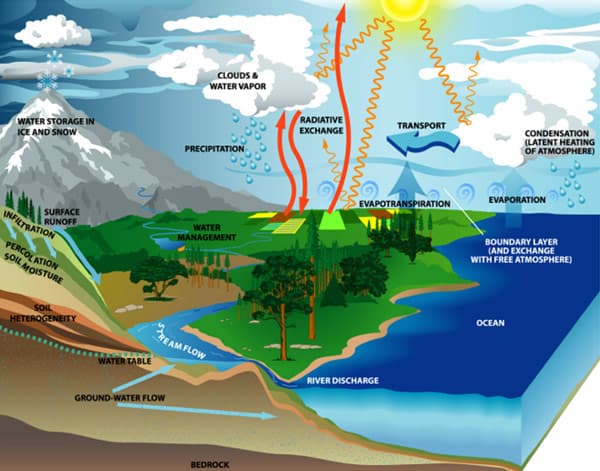Stream: 10 Key Things You Must Know

Overview
A stream, a fundamental feature of the natural landscape, is a small, flowing body of water that channels towards larger rivers, lakes, or oceans. These dynamic watercourses play a crucial role in the Earth's hydrological cycle by transporting water, nutrients, and sediment across diverse ecosystems. Beyond their environmental importance, streams have significant cultural, economic, and recreational value for human societies. This article provides an insightful exploration of streams, revealing ten key aspects that underscore their ecological significance, formation processes, and influence on both nature and human activity.
1. Definition and Characteristics of Streams
Streams are defined as flowing bodies of water smaller than rivers, typically fed by groundwater, precipitation, or melting snow. Characteristically narrow and shallow, streams vary widely in size, flow rate, and origin. Their dynamic nature means they continuously shape their beds and banks through erosion and sediment transport, contributing to landscape formation. Understanding these characteristics helps differentiate streams from other freshwater bodies and highlights their role as vital connectors within watershed systems.
2. Formation and Source of Streams
Most streams originate from springs, melting glaciers, or runoff from rain and snowmelt. Their formation is influenced by topography, geology, and climate. As water collects in higher elevations, it channels downhill, carving out streambeds. The headwaters, or origins, of streams are often in mountainous or elevated regions where precipitation accumulates. This process determines the volume and velocity of water flow, which in turn affects the surrounding ecosystems and downstream water bodies.
3. Ecological Importance of Streams
Streams are crucial habitats for a wide range of aquatic and terrestrial species, serving as corridors for biodiversity. They provide breeding grounds, food sources, and migration routes for fish, amphibians, insects, and birds. The riparian zones alongside streams support unique plant communities that stabilize banks and filter pollutants. Because of their sensitivity to environmental changes, streams are often considered indicators of ecosystem health.
4. Role in the Hydrological Cycle
As integral components of the hydrological cycle, streams facilitate the movement of water from land to larger water bodies like rivers, lakes, and oceans. They contribute to groundwater recharge and maintain wetland conditions that support diverse flora and fauna. Streams also help regulate water temperature and nutrient cycling, maintaining the balance necessary for aquatic life and ensuring the quality of downstream water resources.
5. Streams and Geomorphology
The interaction between flowing water and the Earth's surface defines much of geomorphology. Streams erode soil and rock, transport sediments, and deposit materials downstream, shaping valleys and floodplains. This natural process creates fertile lands around streams but can also lead to issues like erosion and sedimentation, especially when disrupted by human activity. Understanding stream geomorphology is essential for managing landscapes and preventing environmental degradation.
6. Human Uses and Impact on Streams
Humans have long relied on streams for water supply, agriculture, transportation, and recreation. However, urbanization, pollution, damming, and water extraction have significantly impacted stream ecosystems. These actions can alter flow regimes, degrade water quality, and reduce habitat availability for wildlife. Sustainable management practices are vital to preserving stream health and ensuring these water bodies continue to provide essential ecosystem services.
7. Legal and Conservation Status of Streams
Many regions have enacted laws to protect streams from pollution, overuse, and habitat destruction. Conservation efforts focus on maintaining water quality, restoring riparian vegetation, and preventing encroachment. Stream protection is often linked to broader watershed management plans, emphasizing the interconnectedness of water systems. Public awareness campaigns also play a role in encouraging stewardship of these critical natural resources.
8. Streams in Different Climates and Landscapes
Streams vary significantly with climate and geography. In arid regions, streams may be ephemeral, flowing only during rainfall, while in humid areas, they often have continuous flow. Mountain streams tend to be fast-moving and cold, supporting specific species, whereas lowland streams meander slowly through flatter terrains. These variations influence the types of organisms that inhabit streams and the ecosystem services they provide.
9. Streams and Cultural Significance
Throughout history, streams have been central to human civilization, symbolizing life, renewal, and spiritual connection. Many cultures revere specific streams or rivers, incorporating them into rituals and folklore. Streams have inspired art, literature, and music, reflecting humanity's deep appreciation and dependence on freshwater sources. Their preservation is often intertwined with cultural heritage and community identity.
10. Future Challenges and Prospects for Streams
Climate change, pollution, and land-use changes pose significant threats to the health of streams globally. Increased temperatures and altered precipitation patterns can affect stream flow and water quality, disrupting ecosystems. However, advancements in monitoring technology, restoration practices, and policy initiatives offer hope. Protecting streams requires integrated approaches that balance ecological, social, and economic needs, ensuring these vital waterways persist for future generations.
Conclusion
Streams, though often overlooked compared to larger rivers and lakes, are indispensable components of the natural world. They sustain biodiversity, regulate water cycles, sculpt landscapes, and support human communities culturally and economically. Understanding their complexity and challenges enriches our appreciation and underscores the necessity for conscious stewardship. As environmental pressures mount, the future of streams hinges on collective efforts to preserve their health, reflecting the broader imperative to nurture the planet's precious freshwater resources.
References
- US Geological Survey - Streamflow
- Environmental Protection Agency - Why Protect Streams?
- National Geographic - Streams and Rivers
- American Rivers - Importance of Streams
- World Wildlife Fund - Freshwater Habitat
- International Union for Conservation of Nature - Freshwater Ecosystems
- The Nature Conservancy - Stream & River Conservation
- ScienceDirect - Stream Ecology
- National Wildlife Federation - Stream Restoration
- Hydrology and Earth System Sciences - Effects of Climate Change on Streams